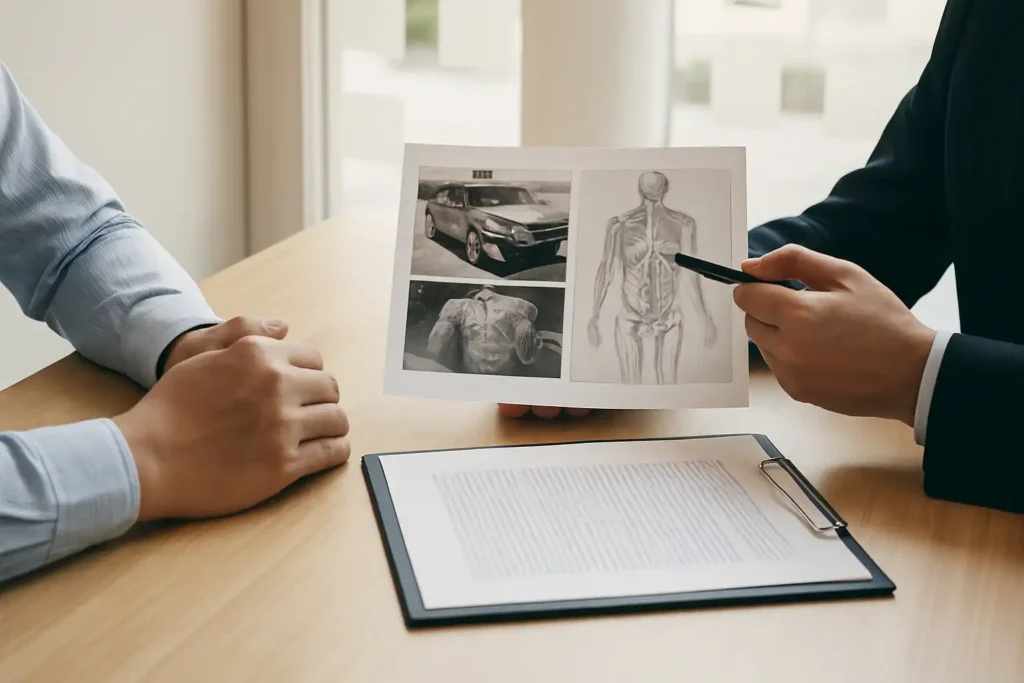After a motorcycle accident, your health and safety come first. But once immediate medical needs are addressed, the next most important step is documenting your injuries. In 2025, insurance companies and courts place heavy emphasis on medical records, photos, and digital evidence when evaluating claims. For riders, understanding motorcycle injury documentation 2025 can make the difference between a denied claim and fair compensation.
Why Documentation Matters in Motorcycle Accident Claims

Motorcyclists are more likely than car occupants to suffer severe injuries, from broken bones to traumatic brain injuries. These injuries often require extensive treatment and long recovery times. Proper documentation is essential because:
- Insurance companies demand proof before paying claims.
- Courts rely on medical evidence to determine damages.
- Detailed records establish a timeline linking the accident to the injuries.
Without thorough documentation, insurers may argue that injuries were pre-existing or exaggerated, reducing settlement offers.
Types of Injury Documentation in 2025
Successful motorcycle accident claims rely on multiple forms of evidence:
- Medical records: Emergency room notes, diagnostic imaging (X-rays, MRIs), surgery reports, and follow-up care records.
- Doctor statements: Professional opinions linking injuries directly to the accident.
- Physical therapy notes: Evidence of ongoing recovery and limitations.
- Prescription records: Proof of medications needed for pain and treatment.
- Accident scene photos: Images of injuries taken immediately after the crash.
- Wearable device data: Fitness trackers or smartwatches showing changes in activity, sleep, or heart rate after the accident.
- Helmet camera footage: Video evidence of the crash itself, proving causation.
Digital Evidence in 2025 Motorcycle Claims

Advances in technology mean digital evidence is more important than ever. In 2025, attorneys often use:
- Electronic medical records (EMR): Easily shareable files that streamline legal proceedings.
- Telemedicine records: Virtual doctor visits, now widely accepted in court as valid evidence.
- Accident reconstruction software: AI-powered models recreate crashes for juries.
This technology ensures that injury claims are supported by clear, reliable evidence.
How Attorneys Use Documentation
Experienced attorneys rely on injury documentation to build strong cases. They use records to:
- Prove the direct link between the accident and the injury.
- Demonstrate the severity and long-term impact of injuries.
- Calculate economic damages, including lost wages and future care costs.
- Support non-economic claims, such as pain and suffering.
In negotiations, detailed evidence makes it harder for insurers to deny or minimize claims.
Compensation Impact in 2025
Well-documented cases typically result in higher settlements. Examples include:
- A rider with broken bones who provides X-rays, surgery records, and physical therapy notes is more likely to secure full compensation for medical costs.
- A traumatic brain injury case supported by MRIs, neurological assessments, and long-term treatment plans can result in a multi-million-dollar verdict.
- Even soft tissue injuries, when backed by physical therapy notes and activity tracker data, can increase settlement amounts.
Without proper documentation, these same injuries may be undervalued or dismissed by insurers.
Common Documentation Mistakes Riders Make

Many riders weaken their own cases by failing to document properly. Common mistakes include:
- Delaying medical care, which creates gaps insurers exploit.
- Failing to follow treatment plans, suggesting the injuries are not serious.
- Not photographing visible injuries immediately after the crash.
- Ignoring digital evidence such as helmet cam or fitness tracker data.
A strong claim requires consistent, reliable documentation from day one.
Steps Riders Should Take After an Accident
If you are injured in a motorcycle crash, follow these steps to protect your claim:
- Seek medical attention immediately, even for minor injuries.
- Request copies of all medical records and diagnostic tests.
- Take photos of injuries as they heal to show progression.
- Keep a recovery journal documenting pain levels, mobility, and emotional impact.
- Save data from wearable devices showing lifestyle changes post-accident.
- Consult an attorney to organize and present documentation effectively.
How Injury Documentation Supports Legal Rights
Accurate injury documentation does more than support compensation—it protects your legal rights. California follows a comparative negligence system, meaning fault can be shared between parties. Strong documentation helps prove the other driver’s actions directly caused your injuries, reducing the chance your compensation will be unfairly reduced.
Conclusion
Motorcycle injury documentation 2025 is more important than ever in accident claims. Medical records, digital evidence, and consistent tracking of recovery form the foundation of successful cases. Riders who carefully document injuries improve their chances of full compensation and protect their legal rights under California law.
If you or a loved one has been injured in a motorcycle crash, consult a motorcycle accident attorney. With strong documentation and skilled legal strategy, you can recover damages and secure the support you need for a full recovery in 2025.



